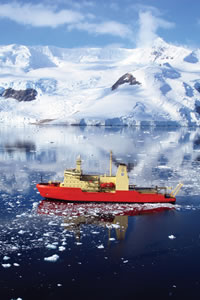Deep Stuff
Whether it’s researching marine life in the darkest depths of the world’s seas, invasive species in the Antarctic or in Hawaii’s mangroves, UH’s Craig Smith goes deep into his subjects
By Chad Pata
E-mail this story | Print this page | Archive | RSS |
 Del.icio.us
Del.icio.us
|
important to know what the human impact will be and how to manage them.”
That is why the census Smith just conducted is so important. He served as part of a panel of scientists advising the International Seabed Authority on the measures needed to protect the myriad of species that will be affected by seafloor mining. The ISA, based out of Jamaica, was set up by the United Nations in 1982 to monitor all activities conducted on the seabed.
The forethought of the U.N. is applauded by Smith, and it’s making a big difference in helping conservation efforts.
“The good thing about managing the mining is that we can set up guidelines and designate protected areas before the damaging extracting activities begin,” says Smith, who has brought in more than $5 million in grants during his time at the university. “The cows are still in the barn; unfortunately, in most conservation efforts around the globe we are playing catch up, we have to promote recovery. But we don’t have to do that in the abyssal ocean and that is nice.”
The census gave them a good start, but their lack of knowledge about how widespread the species are gives Smith pause.
While every sampling they take delivers a whole new group of animals, to ascertain conservation areas for the preservation of certain species is important for scientists to learn if those animals are spread throughout the deep ocean or are limited to these specific areas.
“If the human footprint is small and the species distribution is broad, then species extinctions are unlikely,” says Smith. “But if the footprint is large compared to species ranges, then you really have to be careful how you manage things. The potential footprint for manganese mining is so enormous, it will actually affect a larger area of the surface than any other human activity.”
The response to the study’s recommendations has been well-received, and Smith acknowledges a balance needs to be found between the needs of mankind and the needs of the planet.
But once this economic generator gets started, he sees no way of slowing it down.

|
“The market could probably only sustain one or two mining operations before the copper markets would be saturated,” says Smith. “Once they prove this is economically viable, they won’t stop.
We are going to keep pumping oil until the wells are dry. They’ll start by exploiting a few hundred square kilometers per year but they’ll just keep mowing that lawn, moving across the Central Pacific. In the end it will be many hundreds of billions of dollars.”
Manganese mining is not the only concern on Smith’s radar. He spends a couple months a year in Antarctica, specifically studying the area around the
West Antarctic Peninsula, an area that is warming at the fastest rate on the planet.
The problem here is not species dying off, but rather as the sheet ice melts away it exposes more of the water column to sunlight.
The sunlight creates production of the building blocks of life, creating an explosion of invasive species coming to feed in areas where they could not have survived before.
“Kinds of animals that were previously excluded are now invading. One particular group is the stone crab,” says Smith, who maintains that these crabs have not been in this area for millions of years.
“They are voracious crushing predators, attacking sea urchins and clams, which had no known predators before this. They are rapidly reducing the diversity and affecting the ecosystem structure. Species invasions are one of the things we are really interested in in the Antarctic.”
He estimates the population of crabs to have grown to about 1.5 million, which could be devastating to the native species.
On a positive note, stone crabs are in the King crab family and the population is now large enough to support a fishery, which is the fine line that has to be walked between what is best for humans and the animal world with which we share the planet.
“We see it even in Hawaii. On the list of invasive species man-groves are there, but not the Samoan crab,” says Smith.
“Even though the crab has a big effect on native Hawaiian fauna, but because people like to eat it, it is not invasive. Invasive has a value judgment - invasive is in the eye of the beholder.”
So the eternal balancing act continues, and Smith hopes to stay ahead of the wave in this battle over the abyssal ocean.
But in the end he knows that his recommendations are just that, and he will have to hope that our leaders have listened to what he has had to say when it comes time to make decisions about this mysterious menagerie that resides at the bottom of the sea.
“When politics and economics come together, they have different priorities,” says Smith.
As does Mother Nature.
Page 2 of 2 pages for this story < 1 2
E-mail this story | Print this page | Comments (0) | Archive | RSS
Most Recent Comment(s):








